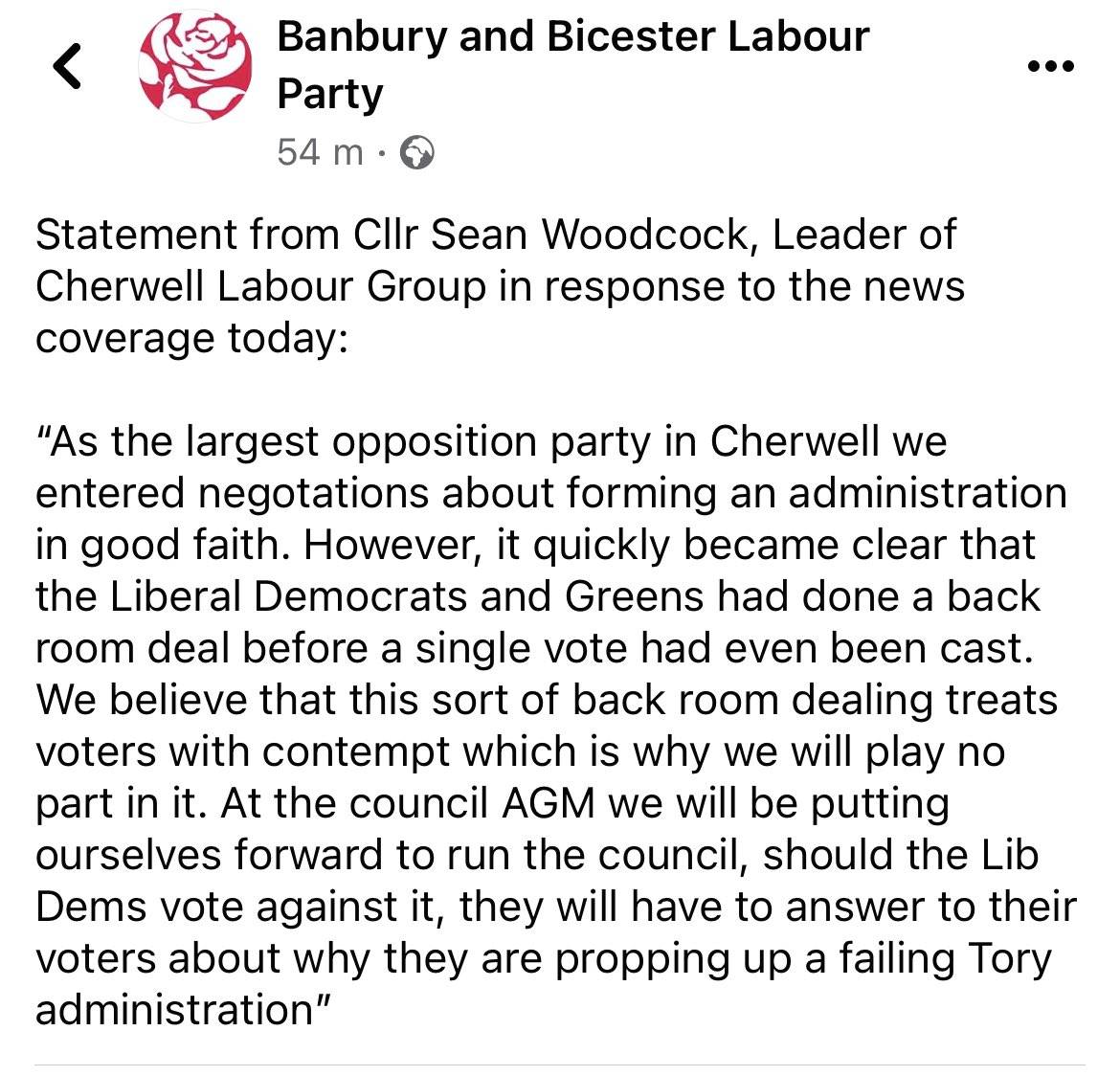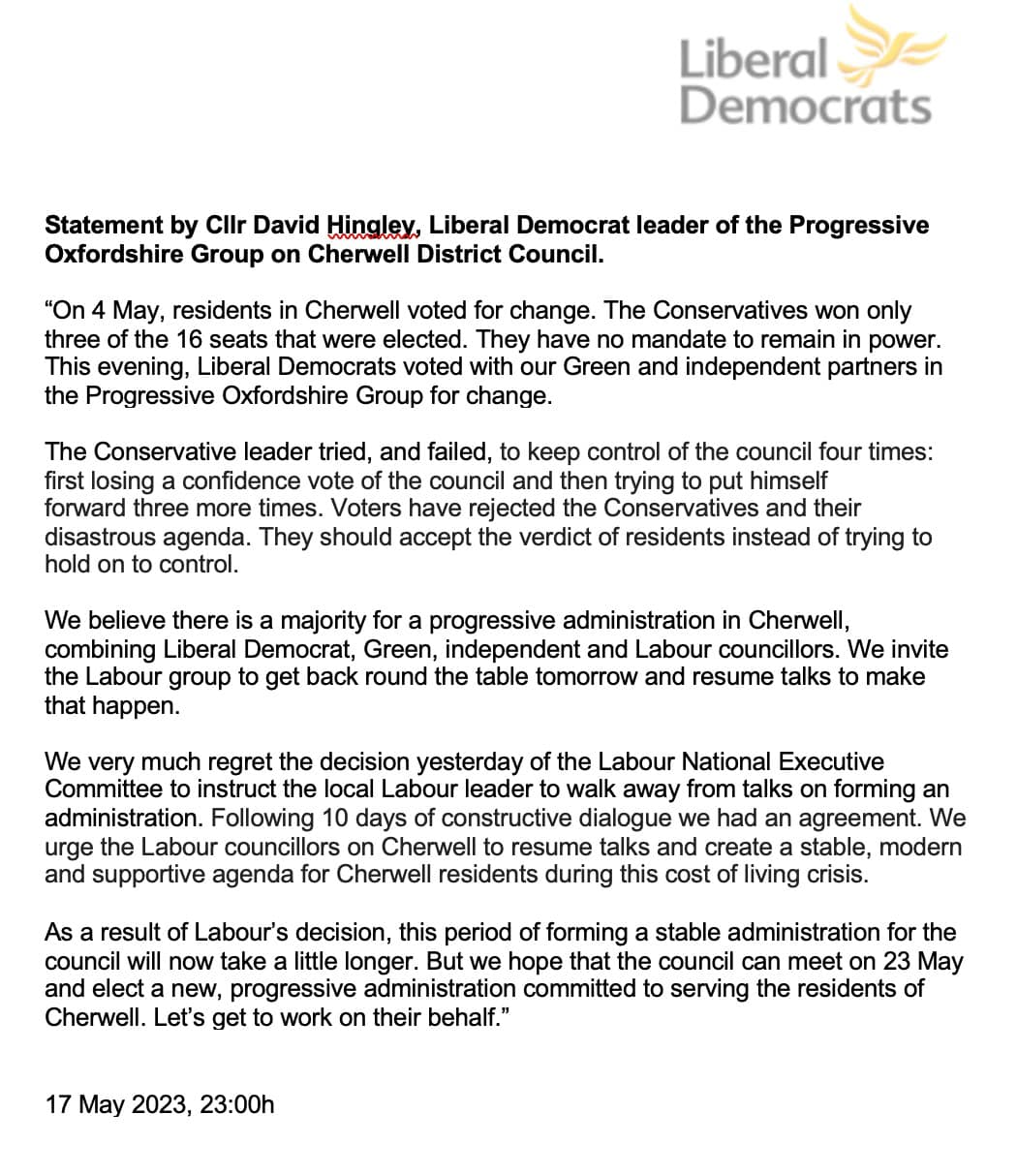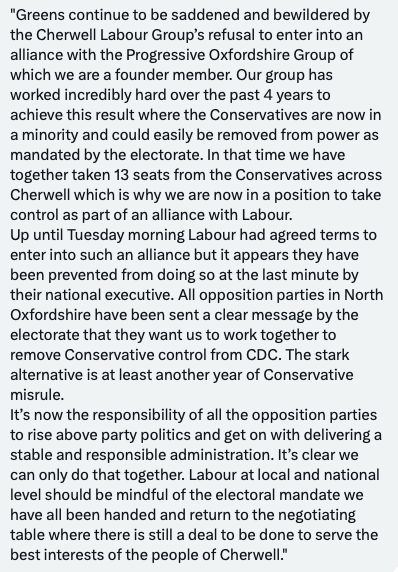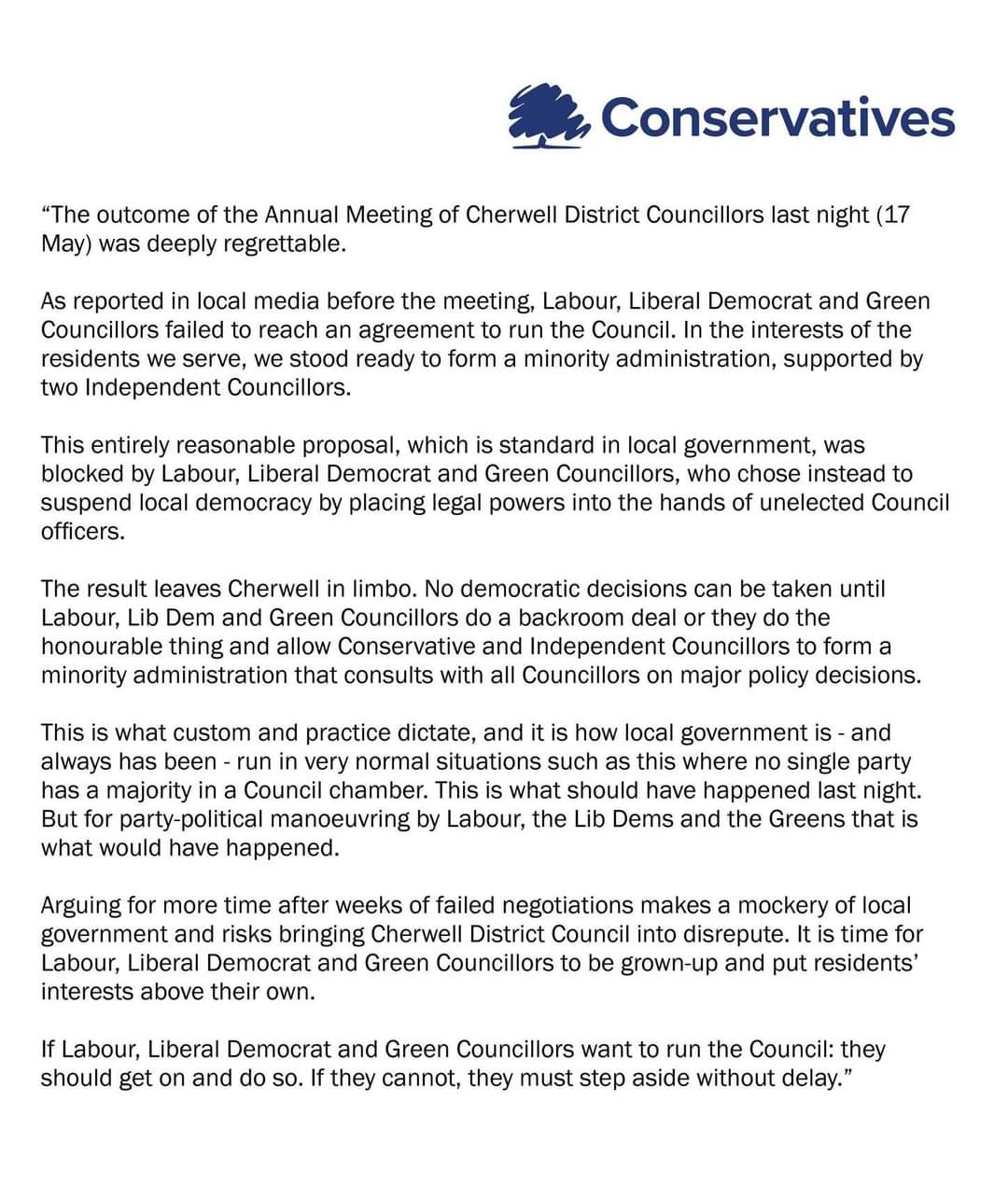What’s happening in Cherwell?

Let’s start with the official statements from the parties.
Labour:

Liberal Democrat:

Green:

Conservative:

After the local elections on 4 May, the state of the parties on Cherwell District Council was:
- Conservative Party: 20 seats
- Labour Party: 12 seats
- Liberal Democrat Party: 10 seats
- Green Party: 3 seats
- Independents: 3 seats
Another way of looking at it is:
- Conservative Group: 20 seats
- Progressive Oxfordshire Group (Liberal Democrat / Green / one Independent): 14 seats
- Labour Group (Labour Party / Labour & Co-operative Party): 12 seats
- Independent Group: 2 seats
So what’s the difference?
Groups and coalitions
Oxfordshire’s councils have two distinct concepts of parties working together.
A “political group” is where a set of councillors tell the council’s proper officer (the council official responsible for its legal obligations) they want to be formally counted under the same umbrella. Sometimes a group will just comprise members of one party. But often it’ll be two, or more, parties working together.
On Oxfordshire County Council, for example, the Conservatives and one independent councillor together form a group, called the “Conservative Independent Alliance”. The LibDems and Greens form another, the “Liberal Democrat Green Alliance”. Labour, its allied Labour & Co-operative Party, and a councillor currently sitting as an independent (Damian Haywood) form a third group.
Cherwell District Council currently has four groups. There’s a Conservative Group with Conservative councillors. There’s the “Progressive Oxfordshire” group, which includes LibDems and Greens plus one Independent. There’s a Labour Group, again with Labour and Labour & Co-operative councillors. The two remaining independents form an Independent Group.
It’s not required, but group parties who are working well together will sometimes stand aside for each other in elections. On May 4, the LibDems and Greens didn’t compete against each other in their target seats: Adderbury Bloxham & Bodicote (LibDem), Bicester South (LibDem), Bicester North (LibDem), Bicester East (Green), Kidlington East (Green), Kidlington West (LibDem), Launton & Otmoor (LibDem). So the LibDems and Greens working together on Cherwell is nothing new. They formed their political group, Progressive Oxfordshire, in May 2022 – thereby displacing Labour to become the official opposition on the council.
Where a group doesn’t have a majority of councillors, they’ll typically partner with other groups to get that majority, forming a “coalition”. This gives them the council leader’s post, which in turn gives the right to appoint a cabinet and control of the council. OCC is run by a coalition of the Liberal Democrat Green Alliance and the Labour & Co-operative Party Group, collectively the “Oxfordshire Fair Deal Alliance”. West Oxfordshire District Council is run by a coalition of the LibDem group, the Labour & Co-operative group, and the Green group, aka the “West Oxfordshire Alliance”.
Still with us? Good. Because this is where the problems begin.
The coalition that never was
Following May’s elections, the Conservatives no longer had a majority on Cherwell District Council. Oxfordshire County Council and West Oxfordshire District Council are both run by coalitions of the LibDems, Labour, and the Greens. Doing the same in Cherwell seemed like a no-brainer.
Discussions duly got underway. As the larger group, the Progressive Oxfordshire group (LibDems/Greens/independent) was expected to take the leader’s post. Labour would have the deputy leadership, as on OCC. (Oxford Clarion understands that this leader/deputy arrangement was originally proposed by Labour.) Cabinet positions would be shared out, including one for the Greens. A press release was drafted with supportive quotes from all three parties.
It turned out that Labour’s National Executive Committee had other ideas.
The NEC is Labour’s national steering body. It insists on approving local coalitions before they begin work, and gave its ok to the coalitions on both OCC (from 2021) and West Oxfordshire (from 2022).
But following May’s elections, the NEC appears to have hardened its stance. It wants Labour to have the strongest role where possible. It believes that is best achieved by allying with only the minimum number of parties required for a workable administration. In the case of Cherwell, the NEC wants a deal with the LibDems, but not the Greens or independents. This would have 22 out of 48 seats, short of a majority – effectively daring the Greens not to vote with the Conservatives. Splitting up the LibDem/Green group would make Labour the largest group in the coalition, thereby giving it the leadership. As the Guardian reports:
Plans for a coalition are at a stalemate after the NEC refused to allow the local Labour party to sign up to a deal with both the Lib Dems and Greens. A Labour source said the party’s policy was to make pacts with the fewest number of parties needed to form a majority.
Having won several seats just a fortnight ago thanks to the Greens standing down (and vice versa), the LibDems are not prepared to renege on their partnership. They pinned the blame squarely on the Labour NEC:
We very much regret the decision yesterday of the Labour National Executive Committee to instruct the local Labour leader to walk away from talks on forming an administration. Following 10 days of constructive dialogue we had an agreement. We urge the Labour councillors on Cherwell to resume talks.
So we have an impasse. Labour does not have enough councillors for a majority, but won’t sign a deal which includes cabinet places for the Greens. The LibDems and Greens don’t have enough councillors for a majority, but won’t split up their partnership to join with Labour. The Conservatives don’t have enough councillors for a majority, though they’re closer, and no other party will give them the votes to get over the line. For now, Cherwell is run by the officers.
Eyes on the prize
For politicians of all hues, but perhaps Labour most of all, the big prize is rapidly appearing over the horizon: the forthcoming General Election.
Boundary changes will see the Banbury constituency, currently held by Victoria Prentis for the Conservatives, carved into two. Banbury itself and the rural north-west will form a continuing Banbury seat, adding Chipping Norton (Labour-voting) and Charlbury (LibDem) from the former Witney seat. Bicester and a belt of Oxford commuterland (Kidlington, Woodstock, Eynsham) will become a new Bicester & Woodstock seat.
If it wasn’t clear before, May’s election results made the leading contenders obvious in each constituency. Labour’s dominance in Banbury itself makes it quite possible that the party could take the Banbury constituency on current polling. The LibDems’ strength in Orbital Oxford and wins in Bicester make them the natural challengers for Bicester & Woodstock.
If you’re hoping to be selected as a parliamentary candidate, with the very real prospect of being elected MP, the last thing you want to do is upset your national party.
So in the space of a few days, Banbury & Bicester Labour went from co-signatories of a never-published press release to publicly pillorying their would-be coalition partners. Just a few minutes after the first council meeting of the year was adjourned at the behest of the LibDems who wanted further talks, the local Labour party launched a petition on the national party website:
Stop the Lib Dem's & Green's grubby deal which has left the council in chaos
Labour made gains across Cherwell, winning more seats than the Liberal Democrats and the Greens. The Liberal Democrats have refused to support Labour and have now left the council in chaos.
Join us in telling the Liberal Democrats and the Greens that Cherwell wants a fresh start.
It’s fair to say that this is not the sort of language recommended by ‘How to Win Friends and Influence People’.
With friends like these…
The Labour statement we quoted at the start of this article says “it quickly became clear that the Liberal Democrats and Greens had done a back room deal before a single vote had even been cast”. The “back room deal” isn’t specified, but the deal between the LibDems and Greens to form the Progressive Oxfordshire group was inked in May 2022, which technically is indeed “before” last Tuesday’s meeting.
Labour sources say that a continued LibDem/Green partnership would be able to outvote Labour in any internal coalition discussions, potentially leading to a Cherwell coalition going against national Labour policy. There is also clearly some personal animus between a few councillors who would find themselves on the same coalition benches, though this is hardly unusual.
The first meeting of the new Cherwell District Council on Wednesday 17 May was not quite as chaotic as OCC’s infamous traffic filters cabinet meeting in November, but for lovers of political intrigue, it was rich in subterfuge. Labour’s attempt to form a minority administration with just 12 out of 48 councillors was always doomed to fail, but it provided the setup for the party to claim “the Liberal Democrats have refused to support Labour”. The Conservatives’ repeated attempts to claim a minority administration under their leader, Barry Wood, were brilliantly parodied by Nathan Briant. The LibDems, who have fewer experienced political operatives than the other Cherwell parties, alternated between evident exasperation and pleading “can’t we all be friends – wait, no, not with the Conservatives”.
What’s at stake?
This is a pivotal year for Cherwell District. The new Local Plan, which determines the shape of building in the district, is due for adoption this year. Cherwell is expected to accommodate a significant slice of Oxford City’s unmet housing need. Conservative-controlled Cherwell and Labour-controlled Oxford City have co-operated on this in recent years.
But this is potentially dangerous for Labour in Cherwell. The plan envisages continued heavy development in Bicester and Kidlington. The Liberal Democrats’ dominance in Vale of White Horse and South Oxfordshire was achieved on the back of unpopular Conservative local plans envisaging massive development.
If Labour and the Conservatives team up to vote through the new Local Plan, the LibDems’ and Greens’ leaflets for next year’s Cherwell elections practically write themselves. To be clear, any gains for the LibDems would be at the expense of the Conservatives, not Labour; Labour’s seats are entirely in Banbury, where the LibDems are weak. But continuing LibDem and Green gains in Kidlington and Bicester would catapult them well in front of Labour on Cherwell District Council.
What next?
The meeting to appoint a leader, adjourned from Wednesday 17 May, is due to reconvene on Tuesday 23. Our current understanding is that Labour have said to the LibDems that they are prepared to enter a coalition only if there are no cabinet roles for the Greens, and that the LibDems are expected to refuse this condition.
The Conservatives will once again try to form a minority administration. Their best hope is that the LibDems will abstain on the vote, which would be enough to get them through. But this is a dangerous option for the LibDems: they get no effective power, while Labour would continually paint them as “letting the Tories in”, blunting any campaigning on the Local Plan.
An eleventh-hour coalition deal could be struck. It’s not hard to envisage a joint leadership, as on Worcester City Council (Labour/Green), or an alternating leadership, as on Wealden District Council (LibDem/Green). But this would require Labour’s NEC to backtrack on its opposition to the Greens.
The stalemate could continue. The policies from the previous Conservative administration would remain in place; the council would effectively be run by officers to this blueprint. Cherwell could then consider moving back from the “leader and cabinet” system to a “committee system”, the old (pre-2000) way of running councils, where committees of councillors decide on each matter. But councillors would have to vote for it to be adopted, and that can’t be taken as read.
Or the Secretary of State for Local Government could intervene, requiring Cherwell to adopt a particular form of governance. A Labour NEC decision ultimately resulting in Michael Gove dictating the shape of Cherwell District Council would be a strange outcome – but don’t bet against it happening.
